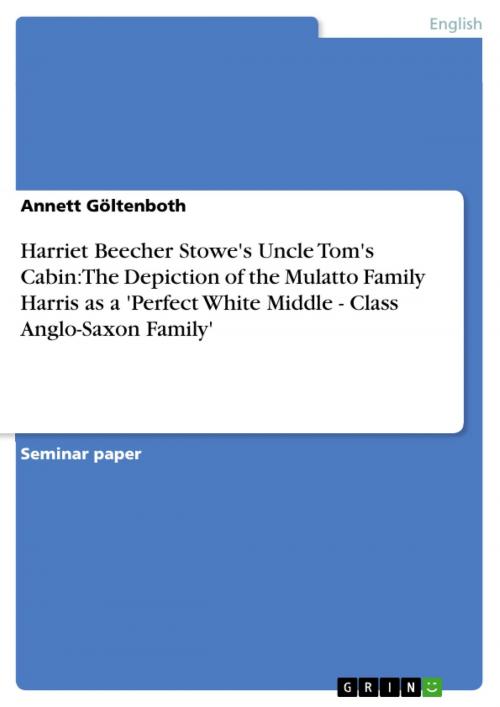Harriet Beecher Stowe's Uncle Tom's Cabin: The Depiction of the Mulatto Family Harris as a 'Perfect White Middle - Class Anglo-Saxon Family'
Class Anglo-Saxon Family'
Nonfiction, Entertainment, Drama, Anthologies| Author: | Annett Göltenboth | ISBN: | 9783638543071 |
| Publisher: | GRIN Publishing | Publication: | September 10, 2006 |
| Imprint: | GRIN Publishing | Language: | English |
| Author: | Annett Göltenboth |
| ISBN: | 9783638543071 |
| Publisher: | GRIN Publishing |
| Publication: | September 10, 2006 |
| Imprint: | GRIN Publishing |
| Language: | English |
Seminar paper from the year 2006 in the subject American Studies - Literature, grade: 1,3, University of Tubingen (Amerikanistik), course: Proseminar II, 17 entries in the bibliography, language: English, abstract: Uncle Tom's Cabin was written by Harriet Beecher Stowe and first published in 1852. The book immediately became a bestseller in both Great Britain and the U.S. and had such an immense influence on its readers, that Lincoln supposedly greeted Mrs. Stowe, at her visit to the White House in 1863, as 'the little woman who wrote the book that made this great war.' (qtd .in Kazin 2003: ix)Uncle Tom's Cabinis very simply put a book about the horrors of slavery. The book has two parallel storylines: the first story is that of the pious slave Tom and his 'adventures' at the farms of his different slave owners. The second story is that of the slaves Eliza, George and Harry Harris who are mulattoes. Eliza and George Harris are a married couple, who are living and working on different farms in the same community. Their son Harry lives with Eliza on the Shelby farm. George, upon being deprived from his privileged work in a factory by his brutal owner, decides to flee to Canada to seek his freedom. Shortly after the escape of George, Eliza, together with her toddler son Harry, also decides to escape from the Shelby farm. Her resolve to escape is based on Mr. Shelby's deal with the salve trader Haley, who forced Mr. Shelby to sell him Harry together with Tom. After surviving lots of perils on their escapes, George, Eliza and Harry are reunited. They reach Canada and freedom, spend 4 years in France, get another child- little Eliza, and finally go back to their 'roots' -to Africa/ Liberia. The story or more correctly the depiction of George and Eliza Harris as a 'perfect white Anglo-Saxon middle class family of the 19thcentury' will be the topic of this term paper. The description of blacks or mulattoes in terms of white categories was quite a novelty in a time in which blacks were often considered as: [...]'child/savage'in counterpoint to their[whites]own self-image: The antithesis of themselves and of what they value, he lacked 'incentive to industry,' 'moral restraint,' the principle of 'accumulation' and control over the 'animal part' of man. (Takaki 1979: 126) Racial stereotypes in 19thcentury America will be further discussed in chapter 2. Chapter 3 will focus on white Anglo-Saxon gender and family concepts. Chapter 4 will present a detailed discussion on how Mrs. Stowe uses these concepts in the description of the mulattoes Eliza and George Harris. Chapter 5 will sum up the discussions of this term paper.
Seminar paper from the year 2006 in the subject American Studies - Literature, grade: 1,3, University of Tubingen (Amerikanistik), course: Proseminar II, 17 entries in the bibliography, language: English, abstract: Uncle Tom's Cabin was written by Harriet Beecher Stowe and first published in 1852. The book immediately became a bestseller in both Great Britain and the U.S. and had such an immense influence on its readers, that Lincoln supposedly greeted Mrs. Stowe, at her visit to the White House in 1863, as 'the little woman who wrote the book that made this great war.' (qtd .in Kazin 2003: ix)Uncle Tom's Cabinis very simply put a book about the horrors of slavery. The book has two parallel storylines: the first story is that of the pious slave Tom and his 'adventures' at the farms of his different slave owners. The second story is that of the slaves Eliza, George and Harry Harris who are mulattoes. Eliza and George Harris are a married couple, who are living and working on different farms in the same community. Their son Harry lives with Eliza on the Shelby farm. George, upon being deprived from his privileged work in a factory by his brutal owner, decides to flee to Canada to seek his freedom. Shortly after the escape of George, Eliza, together with her toddler son Harry, also decides to escape from the Shelby farm. Her resolve to escape is based on Mr. Shelby's deal with the salve trader Haley, who forced Mr. Shelby to sell him Harry together with Tom. After surviving lots of perils on their escapes, George, Eliza and Harry are reunited. They reach Canada and freedom, spend 4 years in France, get another child- little Eliza, and finally go back to their 'roots' -to Africa/ Liberia. The story or more correctly the depiction of George and Eliza Harris as a 'perfect white Anglo-Saxon middle class family of the 19thcentury' will be the topic of this term paper. The description of blacks or mulattoes in terms of white categories was quite a novelty in a time in which blacks were often considered as: [...]'child/savage'in counterpoint to their[whites]own self-image: The antithesis of themselves and of what they value, he lacked 'incentive to industry,' 'moral restraint,' the principle of 'accumulation' and control over the 'animal part' of man. (Takaki 1979: 126) Racial stereotypes in 19thcentury America will be further discussed in chapter 2. Chapter 3 will focus on white Anglo-Saxon gender and family concepts. Chapter 4 will present a detailed discussion on how Mrs. Stowe uses these concepts in the description of the mulattoes Eliza and George Harris. Chapter 5 will sum up the discussions of this term paper.















